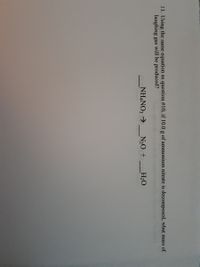
Chemistry
10th Edition
ISBN: 9781305957404
Author: Steven S. Zumdahl, Susan A. Zumdahl, Donald J. DeCoste
Publisher: Cengage Learning
expand_more
expand_more
format_list_bulleted
Concept explainers
Question

Transcribed Image Text:11. Using the same equation as question #10, if 10.0 g of ammonium nitrate is decomposed, what mass of
laughing gas will be produced?
NH,NO3 >
N20 +
H2O
Expert Solution
This question has been solved!
Explore an expertly crafted, step-by-step solution for a thorough understanding of key concepts.
This is a popular solution
Trending nowThis is a popular solution!
Step by stepSolved in 2 steps with 2 images

Knowledge Booster
Learn more about
Need a deep-dive on the concept behind this application? Look no further. Learn more about this topic, chemistry and related others by exploring similar questions and additional content below.Similar questions
- Balance the following chemical reaction. Enter the sum of the balanced coefficients as your answer. Assign "blank" coefficients a value of 1. silver iodide + sodium sulfide → silver sul fide + sodium iodidearrow_forwardIn double-replacement reactions, two substances react to give products at a certain reaction rate. The coefficients in the equation for these types of reactions are represented by lowercase letters: O aA+ bB Cd + cD O aA + dD-cC + bB O aB + Ab cC + dD O aA+bB→ CC + dDarrow_forwardA reaction with 83 grams of aluminum reacts with an excess of bromine gas that produces aluminum bromide. How many grams of bromine gas were used? 4Al + 3Br2 → AlBr3arrow_forward
- I need help understanding how to do this homework question. I've been out sick so I don't even know how to even begin to attempt this question.arrow_forwardUse the following information to answer this question. 2Al) + 3CuCl2(aq)→ 2AICI3(aq) + 3Cu(s) (word equation: aluminum plus three copper(Il) chloride produce two aluminum chloride and three copper) Which of the following best describes what is occurring during this reaction? Select one: O a. Aluminum replaces chlorine in the compound. O b. Aluminum replaces copper in the compound. O c. Copper replaces aluminum in the compound. O d. Chlorine replaces copper in the compound. Smoke Signal.pdf EFiles (1).zip Chap6 SF10 (1).pdfarrow_forwardBalance/complete the following chemical equations, and identify the type of equation.a. KClO3 = KCl + O2b. Acetylene (C2H2) + oxygen = carbon dioxide + waterc. Fe + Cl2d. Barium chloride mixed with sodium sulfatearrow_forward
- Consider the general chemical equation 3A+B→2C. Part A. If 1.45 g of A reacts with 1.75 g of B, what is the mass of C? Express your answer with the appropriate units. Part B. If 4.70 g of A reacts to produce 8.95 g of C, what is the mass of B? Express your answer with the appropriate units.arrow_forwardDo not give handwriting solution.arrow_forwardFrom the list of reactions below, pick out the combustion reactions? 1) 2C2H6(g) + 7O2 (g) → 4CO2(g) + 6H2Ol) 2) MgO(s) + CO2 (g) → MgCO3(s) 3) ZnCO3(s) → ZnO (s) + CO2 (g) 4) 2CH3OH(l) + 3O2 (g) → 2CO2(g) + 4H2O(l) a 1, 2, 3, and 4 b 3 and 4 c 2, 3, and 4 d 1, 3, and 4 e 1 and 4arrow_forward
- 13. Aluminum metal (Al) reacts with sulfur (S) to produce aluminum sulfide (ALS) according to this balanced chemical equation: 2 Al(s) + 3 S(s) → AlS(s) How many atoms of aluminum will react completely with 1.33 x 10 atoms of sulfur?arrow_forwardPlease help with all partsarrow_forwardBalance the following equations (be sure to first convert any chemical names into formulas). Show all steps for balancing or write a brief explanation of your mental process if you were able to balance it in your head. FeCl3 + NaOH → Fe(OH)3 + NaCl P + O2 → P2O5 Lead(II) hydroxide reacts with hydrogen chloride to produce water and lead(II) chloride. Zinc sulfide reacts with aluminum phosphide to produce zinc phosphide and aluminum sulfide.arrow_forward
arrow_back_ios
SEE MORE QUESTIONS
arrow_forward_ios
Recommended textbooks for you
 ChemistryChemistryISBN:9781305957404Author:Steven S. Zumdahl, Susan A. Zumdahl, Donald J. DeCostePublisher:Cengage Learning
ChemistryChemistryISBN:9781305957404Author:Steven S. Zumdahl, Susan A. Zumdahl, Donald J. DeCostePublisher:Cengage Learning ChemistryChemistryISBN:9781259911156Author:Raymond Chang Dr., Jason Overby ProfessorPublisher:McGraw-Hill Education
ChemistryChemistryISBN:9781259911156Author:Raymond Chang Dr., Jason Overby ProfessorPublisher:McGraw-Hill Education Principles of Instrumental AnalysisChemistryISBN:9781305577213Author:Douglas A. Skoog, F. James Holler, Stanley R. CrouchPublisher:Cengage Learning
Principles of Instrumental AnalysisChemistryISBN:9781305577213Author:Douglas A. Skoog, F. James Holler, Stanley R. CrouchPublisher:Cengage Learning Organic ChemistryChemistryISBN:9780078021558Author:Janice Gorzynski Smith Dr.Publisher:McGraw-Hill Education
Organic ChemistryChemistryISBN:9780078021558Author:Janice Gorzynski Smith Dr.Publisher:McGraw-Hill Education Chemistry: Principles and ReactionsChemistryISBN:9781305079373Author:William L. Masterton, Cecile N. HurleyPublisher:Cengage Learning
Chemistry: Principles and ReactionsChemistryISBN:9781305079373Author:William L. Masterton, Cecile N. HurleyPublisher:Cengage Learning Elementary Principles of Chemical Processes, Bind...ChemistryISBN:9781118431221Author:Richard M. Felder, Ronald W. Rousseau, Lisa G. BullardPublisher:WILEY
Elementary Principles of Chemical Processes, Bind...ChemistryISBN:9781118431221Author:Richard M. Felder, Ronald W. Rousseau, Lisa G. BullardPublisher:WILEY

Chemistry
Chemistry
ISBN:9781305957404
Author:Steven S. Zumdahl, Susan A. Zumdahl, Donald J. DeCoste
Publisher:Cengage Learning

Chemistry
Chemistry
ISBN:9781259911156
Author:Raymond Chang Dr., Jason Overby Professor
Publisher:McGraw-Hill Education

Principles of Instrumental Analysis
Chemistry
ISBN:9781305577213
Author:Douglas A. Skoog, F. James Holler, Stanley R. Crouch
Publisher:Cengage Learning

Organic Chemistry
Chemistry
ISBN:9780078021558
Author:Janice Gorzynski Smith Dr.
Publisher:McGraw-Hill Education

Chemistry: Principles and Reactions
Chemistry
ISBN:9781305079373
Author:William L. Masterton, Cecile N. Hurley
Publisher:Cengage Learning

Elementary Principles of Chemical Processes, Bind...
Chemistry
ISBN:9781118431221
Author:Richard M. Felder, Ronald W. Rousseau, Lisa G. Bullard
Publisher:WILEY